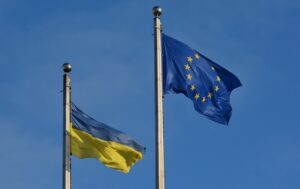
For the protesters waving Palestinian flags outside EU buildings in Brussels, it was the moment that everything might change.
An EU report presented to foreign ministers had found there were indications Israel had breached human rights obligations under the EU-Israel Association Agreement, ahead of Thursday’s European Union leaders’ summit.
The European Union is Israel’s biggest trading partner, and the protesters were demanding that the EU suspend its 25-year-old trade accord over Israel’s actions in Gaza.
But their hopes that EU leaders would agree to suspend the agreement with Israel were soon dashed, because despite the report deep divisions remain over the war in Gaza.
The protesters have been backed by more than 100 NGOs and charities.
In 20 months of Israeli military operations more than 55,000 Gazans have been killed, according to the Hamas-run health ministry. Another 1.9 million people have been displaced.
Israel also imposed a total blockade on humanitarian aid deliveries to Gaza at the start of March, which it partially eased after 11 weeks following pressure from US allies and warnings from global experts that half a million people were facing starvation.
Since then, the UN says more than 400 Palestinians are reported to have been killed by Israeli gunfire or shelling while trying to reach food distribution centres run by a US and Israeli-backed organisation. Another 90 have also reportedly been killed by Israeli forces while attempting to approach convoys of the UN and other aid groups.
“Every red line has been crossed in Gaza” Agnes Bertrand-Sanz from Oxfam told the BBC.
“Every rule has been breached. It really is high time that the European Union acts.”
As the report was made public, it fell to foreign policy chief Kaja Kallas to explain what the European Union would do next.
The EU’s first goal would be to “change the situation” on the ground in Gaza, she said. If that did not happen, “further measures” would be discussed next month on how to suspend the association agreement.
“We will contact Israel to, you know, present our finding,” she stumbled in an uncharacteristically faltering manner. “Because that is the focus of the member states, to really, you know… be very, very sure about the feelings that we have here.”
NGOs said the EU had missed an opportunity to take action and that the response was feeble.
The Israeli foreign ministry called the review “a complete moral and methodological failure.”
For some of the EU’s critics, the episode was a vivid example of how the EU can talk a good game about being the biggest global humanitarian aid donor to Gaza, but badly struggles to present any coherent or powerful voice to match it.
As the world’s biggest market of 450 million people, the EU carries great economic weight but it is not translating into political clout.
“The fact that European countries and the UK are not doing more to put pressure on Israel and to enforce international humanitarian law, it makes it very difficult for these countries to be credible,” said Olivier De Schutter, the UN’s Special Rapporteur on human rights.
“War crimes are being committed at a very large scale In Gaza, there is debate about whether this amounts to genocide, but even if there’s no genocide there is a duty to act.”
De Schutter fears the EU’s soft power is being lost and its inaction makes it much harder for it to persuade to countries in Africa, Asia in Latin America to back Europe on condemning Russia’s war in Ukraine, for example.
Israel maintains it acts within international law and that its mission is to destroy Hamas and bring home the remaining hostages taken when Hamas attacked Israel on 7 October 2023. About 1,200 people were killed in the attack, which triggered Israel’s offensive on Gaza.
As a union of 27 countries, the domestic political reality in Europe makes it unlikely that EU leaders will back the views of the majority of member states on Gaza.
Eleven EU countries have recognised Palestine as a state, and among them Ireland, Spain, Belgium, Slovenia and Sweden had pushed for the European Union’s agreement with Israel to be suspended.
At the heart of the EU’s foreign policy decision-making in Brussels is the fact that decisions have to be unanimous, and so just one dissenting voice can block the EU from taking action.
In this case Germany, Austria, Hungary, Slovakia and the Czech Republic are all opposed.
Austria hopes the EU’s review will spark action, but not necessarily a suspension of the treaty with Israel.
“Everything I’ve heard in this regard will not help the people in Gaza,” said Foreign Minister Beate Meinl-Reisinger. “What it would however cause is a deterioration, if not a complete breakdown of the dialogue we currently have with Israel.”
Germany’s position on Israel has often been shaped by its role in the Holocaust and World War Two.
Chancellor Friedrich Merz says the “current level of attacks on Gaza can no longer be justified by the fight against Hamas”, but he has refused to consider suspending or terminating the agreement.
Slovakia and Hungary are considered more closely aligned politically to Israeli prime minister Benjamin Netanyahu than many other EU countries.
Among the key players advocating tougher measures against Netanyahu’s government is Ireland.
Its foreign affairs minister, Simon Harris, condemned the EU’s handling of the review.
“Our response in relation to Gaza has been much too slow and far too many people have been left to die as genocide has been carried out,” he said.
Israel rejects the charge of genocide and when it closed its embassy in Dublin last December it accused Ireland of antisemitism.
Europe has recently found itself sidelined by Washington on big global issues, notably Ukraine and Iran – with President Donald Trump in favour of direct talks with Russia’s Vladimir Putin and Israel’s Benjamin Netanyahu.
The US may not be in listening mood, but on Gaza the EU has struggled to muster a unified voice on Gaza, let alone make it heard.

On Tuesday, June 24, Horodyshche-Pustovarivska Agrarian Company LLC (GOPAK), a member of the Hals Agro agricultural holding, exported biomethane of its own production for the first time, the industry publication ExPro reported.
According to the publication, the company exported almost 73,000 cubic meters of biomethane stored in Ukrainian underground storage facilities via the gas transportation system through Hungary. The buyer was German Uniper.
Thus, Hals Agro became the third exporter of biomethane, joining VitAgro and MHP.
“Hals Agro is a Ukrainian holding company specializing in grain and sugar production, turkey farming, and meat production. It also produces electricity from renewable energy sources and has four biogas complexes in
Kyiv and Chernihiv regions. The total design capacity is 14.7 MW of green electricity generation.
“Since 2021, Hals Agro has launched two biomethane projects, and in 2023 launched the production of the first industrial biomethane at the Lynovytske Biogas Complex.
Ashroholding has a biomethane plant in Chernihiv region with a capacity of 3 million cubic meters per year. In November 2024, it started pumping biomethane into Ukrainian underground gas storage facilities.

Sales of domestic cheese can be maintained only through the use of promotional sales, and the results of most operators are still far from the level of last year, domestic cheese makers consider the import of European cheese to be the main obstacle, Infagro news agency reported.
“The expected decrease in cheese imports due to the strengthening of the euro has not yet occurred. In May, Ukraine imported 30% more hard, semi-hard and white cheeses. Separately, purchases of hard and semi-hard cheeses increased by 22% compared to May last year,” analysts said.
They noted that imported cheese occupies a fairly significant share of the Ukrainian market, and promotions are used in sales of European cheese no less actively than in sales of Ukrainian cheese.
Despite the huge problems with sales, Ukrainian cheese producers do not reduce base prices for their products, while promotional discounts often reach 25%, Infagro stated.

On Tuesday, the European Commission (EC) put forward a proposal to integrate Ukraine into the EU roaming zone from January 2026.
“We want Ukrainian citizens to stay connected with their loved ones across the EU, as well as in their home country. That is why we are offering Ukraine to join our roaming family. We reaffirm our unwavering commitment to supporting Ukraine and its citizens,” said EC President Ursula von der Leyen.
According to the European Commission’s press release, the implementation of its proposal will allow Ukrainians to call, send text messages, and use their mobile data from Ukrainian phone numbers in 27 EU countries at no extra cost. The same benefits will apply to Europeans who may be in Ukraine.
“Roaming is the first sector in which the EU will extend the internal market regime to Ukraine. In practice, this means that travelers from Ukraine visiting the EU and travelers from the EU visiting Ukraine will not pay any additional roaming charges. All mobile services, including calls, text messages, and data, will be charged at domestic rates,” Brussels explained.
The EC has sent its proposal to the EU Council for approval. According to the proposal, Ukraine will effectively join the EU’s “Roam Like at Home” zone on January 1, 2026, the European Commission said.

The Ministry of Agrarian Policy and Food has allocated sugar quotas for export to European Union countries, which will remain in effect until August 5, 2025, according to the ministry’s press service.
According to the report, the sugar quota has been distributed among exporters in proportion to their actual exports of this product to EU countries in January-May 2025.
The quotas were allocated to the following companies: TOV “Radehivsky Sugar” — 3,977.6 tons, TOV “Tsukoragroprom” — 1,700.9 tons, TOV “PK ”Zorya Podillya” — 927.6 tons, PJSC “Teofipol Sugar Plant” — 915.1 tons, LLC “Narkevychi Sugar Plant” — 688.8 tons, LLC “Novoorzhytskyi Sugar Plant” — 598.4 tons, LLC “Starokostiantynivtsukor” — 451.6 tons, LLC “Shamraivsky Sugar” — 381.5 tons, LLC “Shepetivka Sugar” — 349.5 tons, LLC “Signet-Center” — 259.4 tons, LLC “Agrocomplex ”Green Valley” — 216.5 tons, Kraievyd LLC — 184.2 tons, Novomyrhorodsky Sugar LLC — 140.7 tons, Prisma-14 LLC — 121.7 tons, and Krasylivsky Sugar Plant PJSC — 94.0 tons.

The European Commission has confirmed the disbursement of the fifth tranche of emergency macro-financial assistance (MFA) to Ukraine in the amount of €1 billion under the ERA, which will be repaid from frozen Russian state assets.
“This further strengthens the EU’s role as Ukraine’s largest donor since the start of Russia’s aggressive war, with total support approaching €150 billion,” the European Commission said on Friday.
It is specified that the total MFA amounts to EUR 18.1 billion and is the EU’s contribution to the G7 Emergency Revenue Acceleration (ERA) initiative, which aims to provide Ukraine with financial support of approximately EUR 45 billion.
“These loans are to be repaid from the proceeds of Russian state assets frozen in the EU. With this latest payment, the total amount of Commission loans to Ukraine under this MFA will reach EUR 7 billion from the beginning of 2025,” the EC said.
The press release also recalls that “as agreed by European leaders at the Special European Council in early March and confirmed by President Ursula von der Leyen, the Commission stands ready to allocate the EU’s contribution to the ERA loan initiative if necessary.”
“It is in close contact with the Ukrainian authorities on the next disbursements. If Ukraine submits a request, the Commission is ready to respond quickly. This will allow the EU to support any significant increase in military spending in the coming weeks and months, helping to ensure that Ukraine is in a strong position ahead of any potential peace talks,” the press release emphasizes.